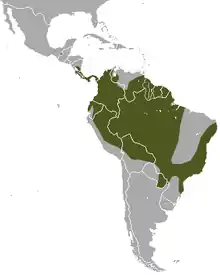Brown four-eyed opossum
The brown four-eyed opossum (Metachirus nudicaudatus) is a pouchless marsupial[3] of the family Didelphidae. It is found in different forested habitats of Central and South America,[2] from Nicaragua to Paraguay and northern Argentina,[1] including southeastern Colombia, western Brazil and eastern Peru and Bolivia, at elevations from sea level to 1500 m.[2] It is the only recognized species in the genus Metachirus,[1] but molecular phylogenetics studies suggest that it should probably be split into several species.[2] Population densities are usually low, and it is uncommon in parts of Central America.[2] A density of 25.6/km2 was reported near Manaus, Brazil.[3] Its karyotype has 2n = 14 and FN = 24.[3]
| Brown four-eyed opossum[1] | |
|---|---|
.jpg.webp) | |
| Scientific classification | |
| Kingdom: | Animalia |
| Phylum: | Chordata |
| Class: | Mammalia |
| Infraclass: | Marsupialia |
| Order: | Didelphimorphia |
| Family: | Didelphidae |
| Subfamily: | Didelphinae |
| Tribe: | Metachirini Reig et al., 1987 |
| Genus: | Metachirus Burmeister, 1854 |
| Species: | M. nudicaudatus |
| Binomial name | |
| Metachirus nudicaudatus (É. Geoffroy, 1803) | |
 | |
| Brown four-eyed opossum range | |
It is a nocturnal, solitary,[2] strongly terrestrial and omnivorous animal, feeding on fruits, small vertebrates and invertebrates.[3]
The brown four-eyed opossum builds nests made of leaves and twigs in tree branches or under rocks and logs.[4] It is seasonally polyestrous and the litter size varies from one to nine.[3]
The white spot over each eye inspired the common name of "four-eyed opossum". Its scaly tail is longer than its body.[3]
The opossum appears to be mostly insectivorous, though also consumes some types of fruit seeds, small vertebrate creatures like birds and reptiles and invertebrates like crayfish and snails.[5] The brown four-eyed opossum is a host of the Acanthocephalan intestinal parasite Gigantorhynchus ortizi.[6]
References
- Gardner, A.L. (2005). "Order Didelphimorphia". In Wilson, D.E.; Reeder, D.M (eds.). Mammal Species of the World: A Taxonomic and Geographic Reference (3rd ed.). Johns Hopkins University Press. p. 12. ISBN 978-0-8018-8221-0. OCLC 62265494.
- Brito, D.; Astua de Moraes, D.; Lew, D. & de la Sancha, N. (2011). "Metachirus nudicaudatus". IUCN Red List of Threatened Species. 2011. Retrieved 18 January 2012.CS1 maint: ref=harv (link)
- Eisenberg, John F.; Redford, Kent H. (May 15, 2000). Mammals of the Neotropics, Volume 3: The Central Neotropics: Ecuador, Peru, Bolivia, Brazil. University of Chicago Press. pp. 77–78. ISBN 978-0-226-19542-1. OCLC 493329394.
- Bies, L. (2002). "Metachirus nudicaudatus". Animal Diversity Web. University of Michigan Museum of Zoology. Retrieved 2012-01-13.
- Gardner, Alfred. Mammals of South America Volume 1. University of Chicago Press. p. 34.
- Nascimento Gomes, Ana Paula; Cesário, Clarice Silva; Olifiers, Natalie; de Cassia Bianchi, Rita; Maldonado, Arnaldo; Vilela, Roberto do Val (December 2019). "New morphological and genetic data of Gigantorhynchus echinodiscus (Diesing, 1851) (Acanthocephala: Archiacanthocephala) in the giant anteater Myrmecophaga tridactyla Linnaeus, 1758 (Pilosa: Myrmecophagidae)". International Journal for Parasitology: Parasites and Wildlife. 10: 281–288. doi:10.1016/j.ijppaw.2019.09.008. PMC 6906829. PMID 31867208.
